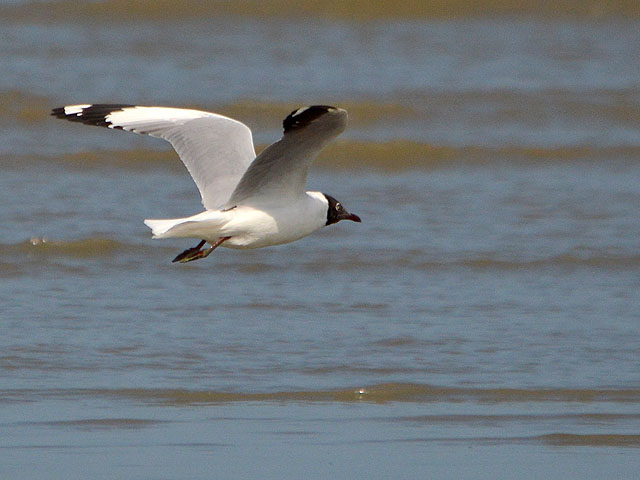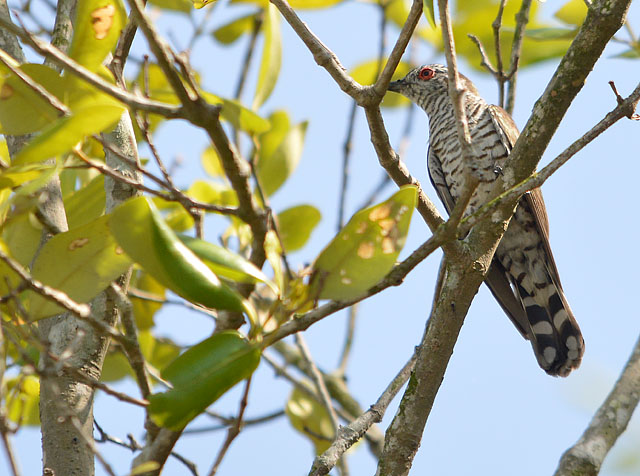It was favourable day to
spend some time at the beach. I reached my destination just after the break of
dawn and found myself a nice little spot in which to uncoil after another
hectic week at the office. The coastline here at Teluk Air Tawar – Kuala Muda
is bleak with mudflats as far as the eye can see. Not exactly the type normal
folks tend to flock to for a day at the beach but birders are not normal folks
to begin with. Due to the current hot spell, I decided to do my observation
from the edge of a small patch of mangroves as the vegetation will be my saviour
from the relentless heat that is to come. The trees will also help to break my
human form and hopefully, deceived the birds long enough for me to obtain some
images when the rising tide pushes them closer to shore.
The migratory season is
drawing to an end and some of the water birds would now be sporting their respective
breeding plumages. That is one of the main reasons for my visit here today to Penang’s
only Important Bird and Biodiversity Area (IBA). Pond-herons are common
migrants throughout the country. Only during this time of year can one
distinguish the three different species that occur here. Surprisingly, all the Pond-Herons
that were in breeding plumage were the rarer Javan Pond-Herons. With most of
the waders being well out of range, this stunning water bird had most of my
attention. There is a certain degree of colour variation to the breeding
plumage. Some individual are blondes – hence the title of this post.
Some, on the other hand, are
more brunettes than blondes. One of these darker birds was very confiding today
and provided good photographic opportunities.
The Pond-Herons have
developed a strategy to help them hunt more successfully. They can be seen in
close proximity with another predator of the mudflats here and it is the
Dog-faced Water Snake. Preys evading the reptilian predator would
unintentionally exposed themselves to the avian predator. I am not sure if any
favour is returned to the snake. Well, life is not fair all the time.
One these snakes slithered
reasonably close to my position on one occasion and I tried my best to obtain
some images.
The absence of the much
commoner Chinese Pond-Herons was a little puzzling. Then one flew into view and
put my mind to ease. The lighting was brilliant today and my modest setup could
capture some of the action shots. I guess that helped to compensate for the
lack of uncommon waders on this visit.
The Chinese Pond-Heron may be
the commonest of the Pond-Herons but its breeding plumage is the most vibrant
in my book. The Indian Pond-Heron was sorely missed today. It is the rarest of
them all but the breeding colours does not even come close to the former.
Egrets were plentiful today
as expected. Only the Little Egret and Great Egret were present and they were
foraging way out beyond the mudflats. A lone Little Egret did fly past close and
I am quite happy with how the image turned out.
Some of the waders like the
Lesser Sand-Plovers and Curlew Sandpipers are sporting their brilliant breeding
plumages. Distance, however, is usually an issue when it comes to wader
watching. And today, it would have been futile to try and capture their images.
One species did come very close to shore with the rising tide and it was a
flock of Pacific Golden Plovers.
A few showed some traces of their
breeding plumage. Had they been in full breeding plumage, it would have been
sensational. The Pacific Golden Plover undergoes one of the most intense changes
and its breeding plumage is absolutely gorgeous.
The Common Sandpiper is not
only common but has a high level of tolerance towards human intrusion.
Throughout my time at the stake out among the mangroves, a few of them were
foraging, fighting and resting just in front of me.
Despite their reputation of
being guardians of the marsh, Common Redshanks are usually confiding if one is
unobtrusive enough.
A leucistic individual held my
attention for a substantial period of time. Things were starting to become
stale by mid morning. Imagination and hallucination is not uncommon when one
has been staring at a landscape of mud and surf for hours. Reality finally
kicked in when the pale bird foraged alongside a typical bird. But it was good
fun. It helped pass the time while I hoped for the tide to bring in something
interesting.
A hunting Collared Kingfisher
provided additional excitement to the trip. Crabs are its preferred prey and
the lighting today made it possible for me to capture some feeding shots.
Gulls are generally rare in Malaysia
except for this location. For years, a number of Brown-headed Gulls have been
wintering here without fail. It may not be the rarity I was hoping for but a
Brown-headed Gull almost in full breeding plumage has enough panache to escalate
the trip to another level.
In any plumage stage, this
gull is easier to identify in flight due to its distinct wing tip pattern. Lucky
for me, it only took flight after I have taken several shots.
The reason for the gull’s abrupt
departure was soon made clear to me. A group of Smooth Otters returning back to
land after a morning out did not go down well with most of the birds present.
They slid their way across the mudflats and this choice of locomotion although effective,
is adorable and humorous to watch. Like mischievous puppies making a mess of
things, I could not stay angry at these aquatic mammals for long.
I am not sure if they are
unaware of my presence or they are simply not bothered, the otters scamper up
on shore quite close to me. However, the vegetation made it difficult to
capture unobstructed images. I decided to pack up shortly after and it was not
because of the otters. The tide has now left very little mud exposed and hardly
any waders were left.
A little bird perched at the
top of a mangrove tree delayed my departure from the locality. The Little
Bronze Cuckoo is more often heard than seen. I took the effort to try and
obtain some images but luck was not on my side. The foliage hampered my
efforts.
I decided to swing by the
swamp forest of Air Hitam Dalam just to see if anything was up and about. The
migratory Blue-winged Pitta has arrived but remained shy. On the other hand, the
Taiga Flycatcher should be migrating back north soon and I was glad I managed
to spend some time with it as I may not have another chance.
Birding and bird photography rely
heavily on luck. You find yourself an impressive nocturnal bird of prey. You
stalk your way until you are within range for a shot. However, you find
yourself with only one window among the foliage that the subject, a Spotted
Wood-Owl, is unobstructed. Except for a big branch blocking half the head. And
life goes on for this old school birder.
A picture of blissful living
by the wonders of Mother Nature. That would be the type of tagline I had to
think up back in the day when I was a copywriter at a creative agency. Anyway,
the Long-tailed Macaques are certainly having it good here at Air Hitam Dalam. The
day did not yield as many species as I have hoped for but it is always good to
spend some time in the field.
The checklist of birds recorded:
1. Bagan Belat
2. Air Hitam Dalam


































2 comments:
Did you use any playback to draw out the flycatcher?
It was already on that perch when I came across it.
Post a Comment